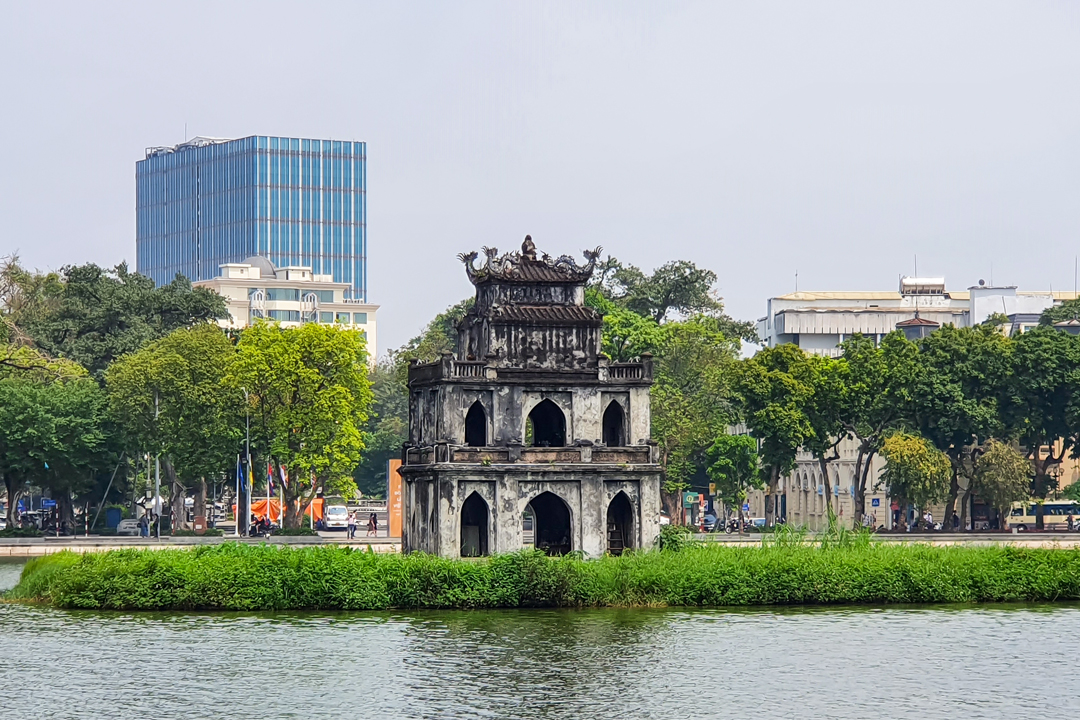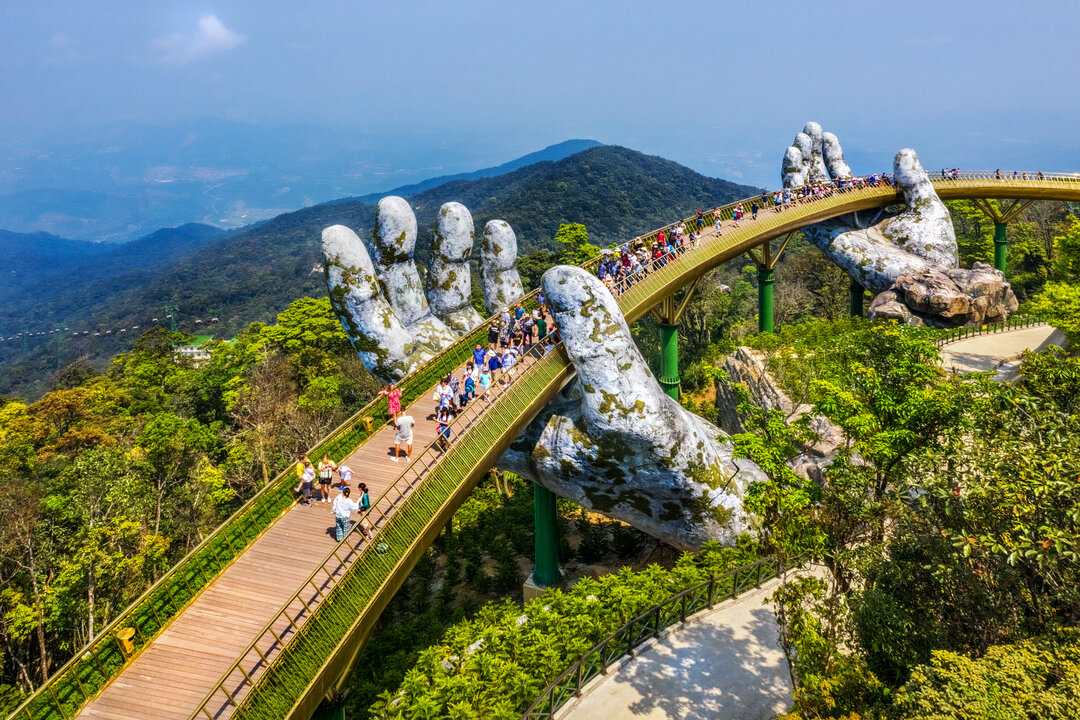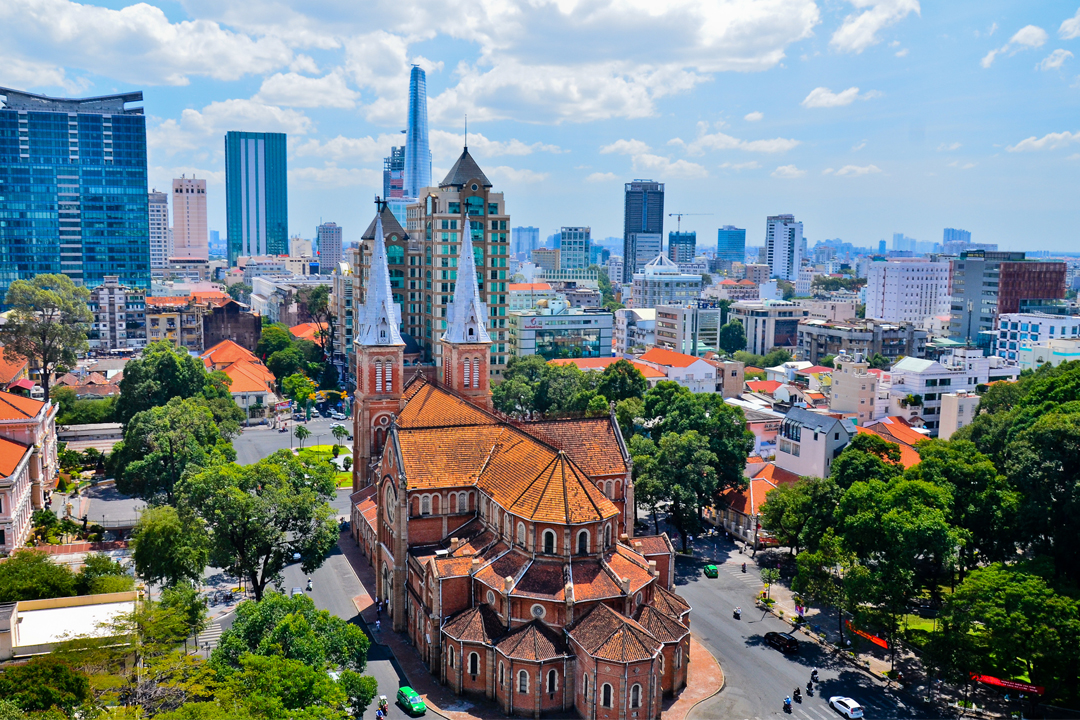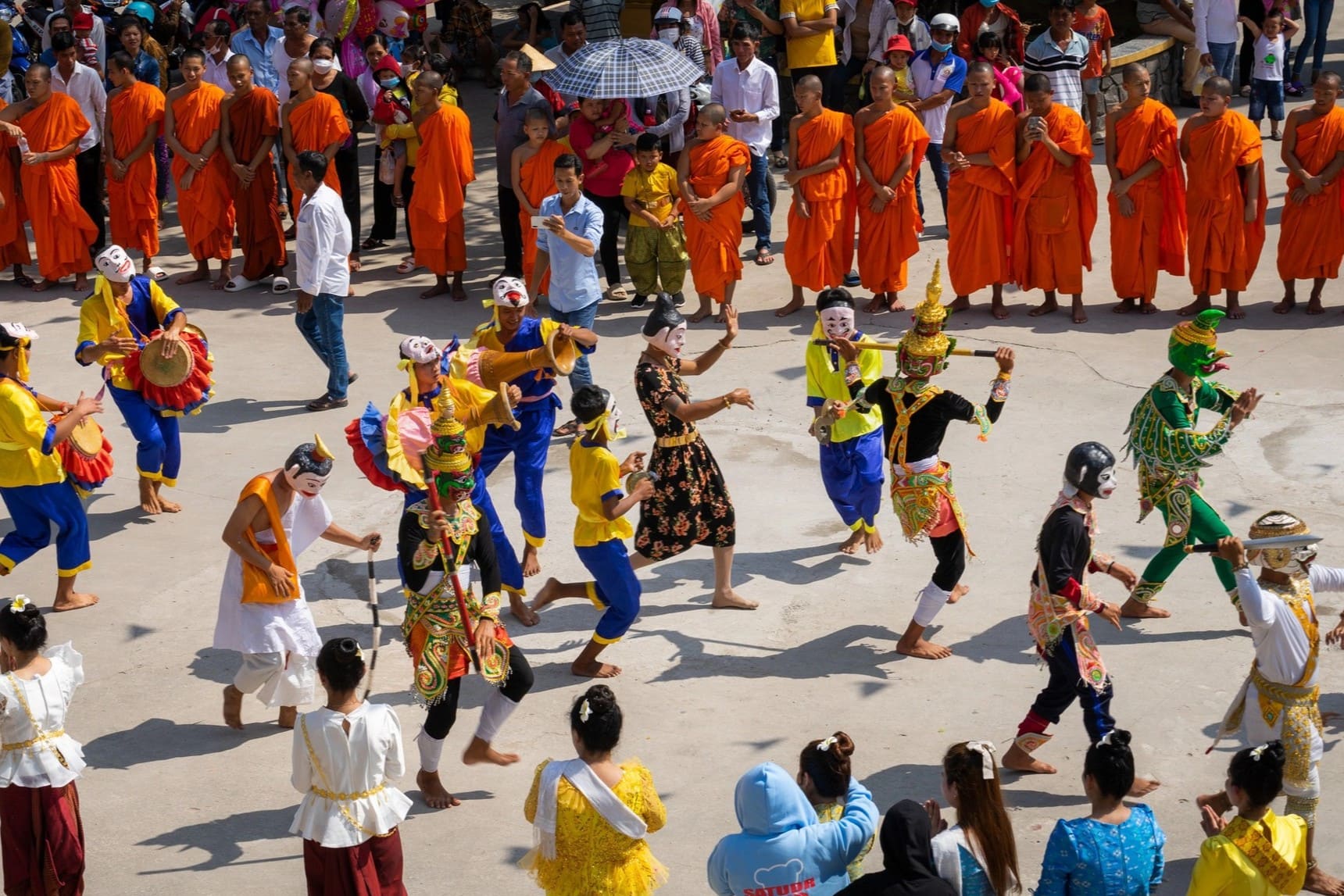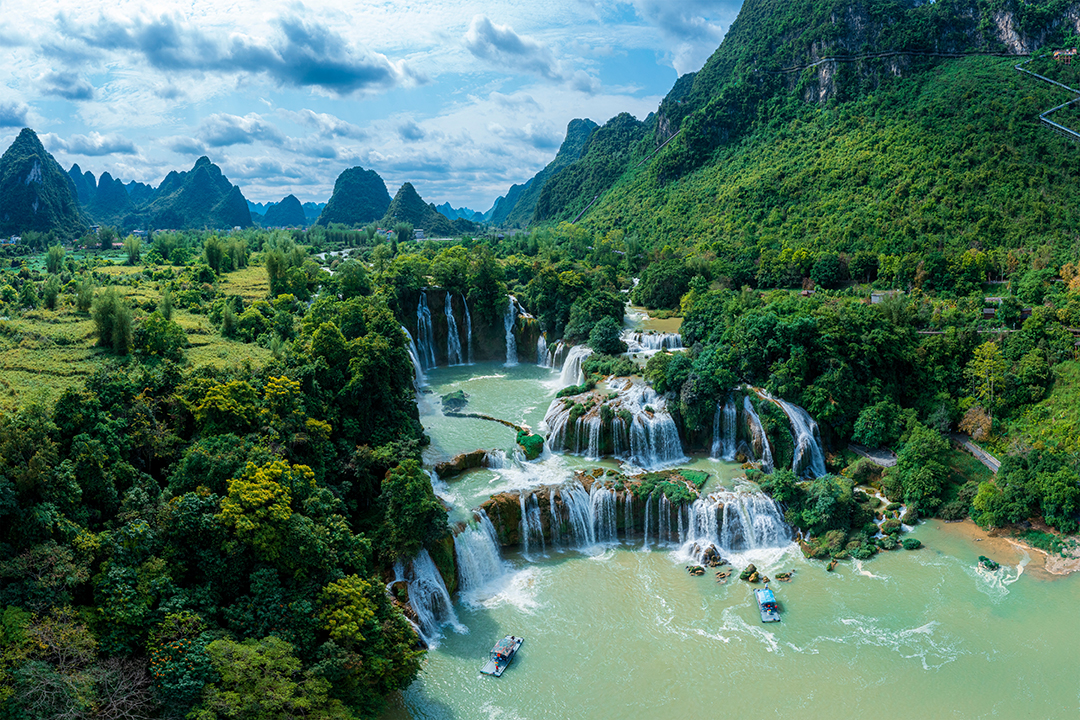Ban Gioc Waterfall: Overview, Things To Do & Travel Guide
Ban Gioc Waterfall is a breathtaking natural wonder it’s a testament to nature’s raw power. Here, the Quay Son River tumbles over terraced limestone cliffs, forming one of Asia’s most stunning transnational waterfalls. Straddling the Vietnam-China border, Ban Gioc is often compared to Niagara and Iguazu, yet it remains a hidden gem, untouched by mass tourism. In 2021, Travel + Leisure recognized it as one of the world’s 25 most beautiful waterfalls. Beyond its striking beauty, Ban Gioc is deeply connected to the history, geography, and culture of Cao Bang Province, home to the Tay and Nung ethnic groups.
Ban Gioc is more than a scenic marvel it's a gateway to karst landscapes, mystical caves like Nguom Ngao, and cultural gems like Truc Lam Ban Gioc Pagoda. If you seek adventure, stunning photography, or a peaceful retreat into nature, exploring Ban Gioc unveils a world of hidden treasures. This guide will take you through everything you need to know, from its fascinating history to expert travel tips, ensuring you experience Ban Gioc like a true explorer.
Overview of Ban Gioc Waterfall
Ban Gioc Waterfall is the largest natural waterfall in Southeast Asia and the fourth-largest transnational waterfall in the world. Spanning 300 meters in width and cascading 35 meters down terraced limestone formations, it marks the Vietnam-China border and offers a breathtaking display of nature’s power.
The waterfall spans 300 meters in width and consists of two sections: the main waterfall, shared between Vietnam and China, and the secondary waterfall, entirely within Vietnam’s territory. According to the 1999 Land Border Treaty, the secondary waterfall belongs solely to Vietnam, while the main waterfall is divided between the two nations. The main section, towering 70 meters high with a depth of 60 meters, cascades down three tiers, forming multiple streams of rushing water. From a height of over 60 meters, torrents crash down terraced rocks, creating a spectacle of white silk-like ribbons weaving through the lush green mountains. At its base, the Quay Son River flows peacefully, its wide surface flanked by grassy meadows and pristine forests, shared by both countries.
Beyond its natural beauty, Ban Gioc is a cultural and historical treasure. The nearby Truc Lam Ban Gioc Pagoda provides panoramic views and symbolizes peace between Vietnam and China. The region is home to the Tay and Nung ethnic communities, known for their rich traditions. In 2023, Ban Gioc set a Vietnamese record with 1,000 performers showcasing "Then" singing and “gourd lute” (Traditional instruments of the Tay people) by the falls, honoring its rich cultural heritage.
The surrounding karst landscape is home to remarkable sites like Nguom Ngao Cave, a stunning limestone cavern filled with intricate stalactites and stalagmites. Pac Bo Cave, meanwhile, holds immense historical significance as the place where Ho Chi Minh strategized revolutionary activities upon his return to Vietnam. These destinations enhance the natural allure of Ban Gioc and offer visitors a deeper understanding of the region’s rich history, cultural heritage, and unique geological formations.
With its unparalleled natural beauty, cultural richness, and historical significance, Ban Gioc Waterfall is more than just a scenic marvel; it is a must-visit destination showcasing the harmony of nature and tradition. Ban Gioc Waterfall is more than just a scenic destination; it is a symbol of the dynamic relationship between nature, history, and culture. If you visited for its breathtaking views, geological wonders, or cultural richness, the waterfall remains a must-see attraction for travelers exploring Northern Vietnam.
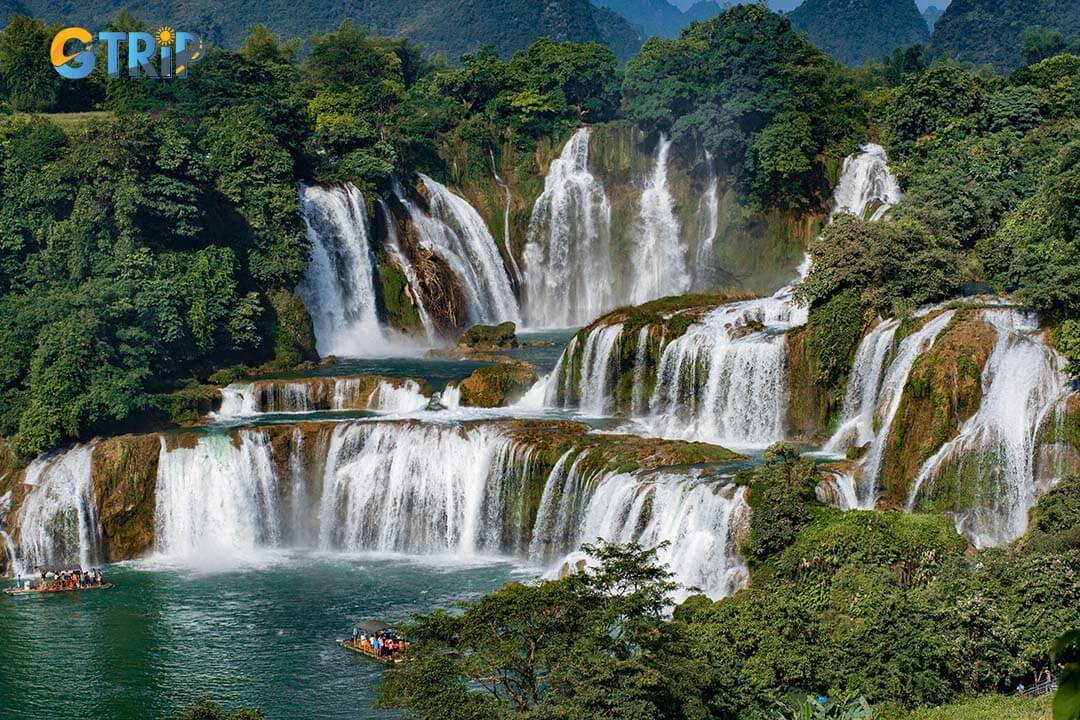
Ban Gioc Waterfall captivates with its majestic cascades, rich cultural heritage, and stunning karst landscapes along the Vietnam-China border
4 things to do when visiting Ban Gioc Waterfall
Ban Gioc Waterfall is a breathtaking natural wonder and a destination rich in cultural and adventure experiences. You can explore its stunning landscapes, embark on boat tours, hike through the surrounding karst mountains, and engage with local ethnic communities. Below are the top activities that will enhance your visit to Ban Gioc Waterfall.
1. Participate in boat tours to enjoy the waterfall up close
One of the most immersive ways to experience Ban Gioc Waterfall is by taking a traditional bamboo raft tour along the Quay Son River. These boat tours allow you to get as close as possible to the cascading waters, where you can feel the cool mist and hear the powerful roar of the falls. Guided by local boatmen, the raft follows a safe route to the waterfall’s base. This intimate proximity offers unparalleled photographic opportunities to capture the multi-tiered cascades and the natural limestone formations that frame the scene.
The entire journey lasts between 10 to 20 minutes, providing ample time to soak in the breathtaking views and snap memorable photos. Many ride early or late for golden light and fewer crowds, ensuring a serene experience. The boat tour is a unique way to appreciate the natural beauty of Ban Gioc and it provides insight into the local way of life along the river.
The bamboo raft ride is typically priced at around 50,000 VND (approximately $1.96) per person. Safety is a priority, so life jackets are provided for all passengers, ensuring that even near the powerful falls, the experience remains secure and enjoyable. For photographers and nature lovers alike, this close-up encounter with Ban Gioc Waterfall showcases its raw beauty.
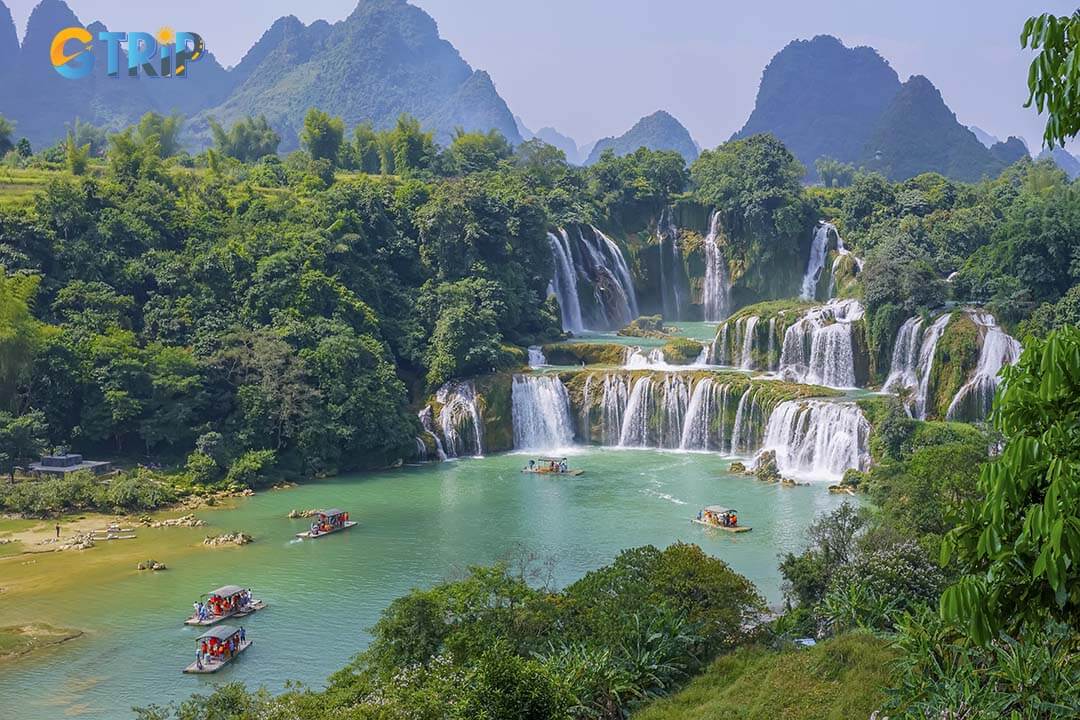
A bamboo raft tour on the Quay Son River offers an up-close, immersive experience of Ban Gioc Waterfall, blending breathtaking views with local culture
2. Take photos at the Ban Gioc rice fields
Surrounding Ban Gioc Waterfall, the vast rice fields of Cao Bang present a stunning rural landscape that changes with the seasons. Cultivated by the Tay and Nung people, these fields enrich Ban Gioc’s scenic charm. From late September to early October, golden rice fields contrast with the emerald Quay Son River and towering karsts.
For photography enthusiasts, this time of year is perfect for capturing the breathtaking harmony of nature and local life. Early morning offers soft, diffused lighting that enhances the golden hues of the rice fields and casts a gentle mist over the valley, adding a dreamy effect to photos. Late afternoon, especially during golden hour, bathes the landscape in warm tones, creating long shadows and highlighting the intricate textures of the rice fields.
Beyond landscape photography, the rice fields also provide an opportunity to capture authentic cultural moments. During the harvest season, you can see local farmers wearing traditional clothing, working in the fields with hand tools, and leading water buffalo through the paddies. These daily activities offer a glimpse into the agricultural traditions that have been passed down for generations. Engaging with the locals, learning about their farming techniques, and even joining in on the harvest can add a meaningful storytelling element to your photography.
For the best viewpoints, hike up nearby hills or find elevated spots along the Quay Son River. These vantage points offer panoramic shots of the waterfall, rice fields, and mountains in one frame. The breathtaking scenery from these heights creates a perfect backdrop for capturing the serene beauty of Ban Gioc in all its glory.
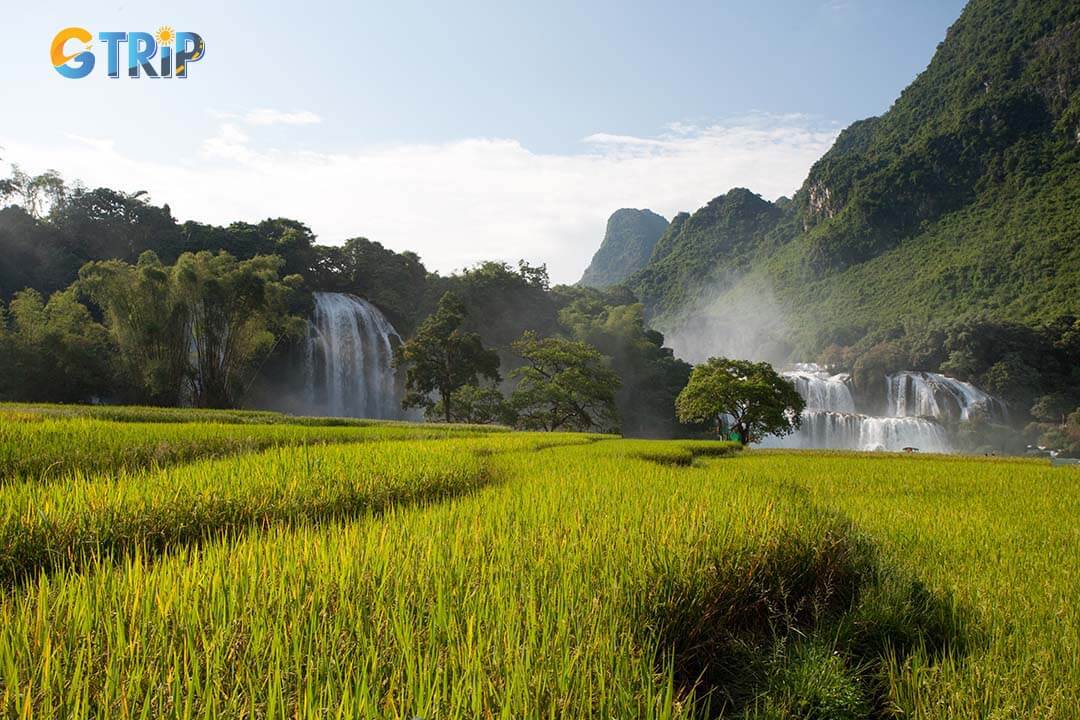
The rice fields of Cao Bang create a breathtaking seasonal landscape that perfectly complements Ban Gioc Waterfall’s natural beauty
3. Enjoy the local culture when traveling at Ban Gioc Waterfall
At Ban Gioc Waterfall, immersing yourself in local life is an integral part of the journey. You can begin by visiting nearby villages where the Tay and Nung ethnic communities proudly showcase their traditions. Here, you can even try your hand at the craft, gaining an appreciation for the meticulous techniques passed down through generations.
Another engaging activity is staying in traditional Tay and Nung homestays. These stilt houses provide a comfortable retreat and an authentic experience of rural Vietnamese hospitality. Sharing meals prepared with locally sourced ingredients, you learn about regional recipes and participate in daily routines that have remained unchanged for centuries. Strolling through local markets reveals vibrant stalls with handmade textiles, bamboo crafts, and regional specialties like five-color sticky rice.
Furthermore, you can join in local cultural performances that bring the region’s folklore to life. Participate in or simply observe traditional folk songs, known as Luon Slang and Then Singing, where each melody tells a story of love, nature, and heritage.
By directly engaging with these cultural activities, you enrich your travel experience and contribute to the preservation of a vibrant heritage. Engaging in local crafts, cuisine, or dance at Ban Gioc offers a hands-on glimpse into borderland life and deepens your connection to the community.
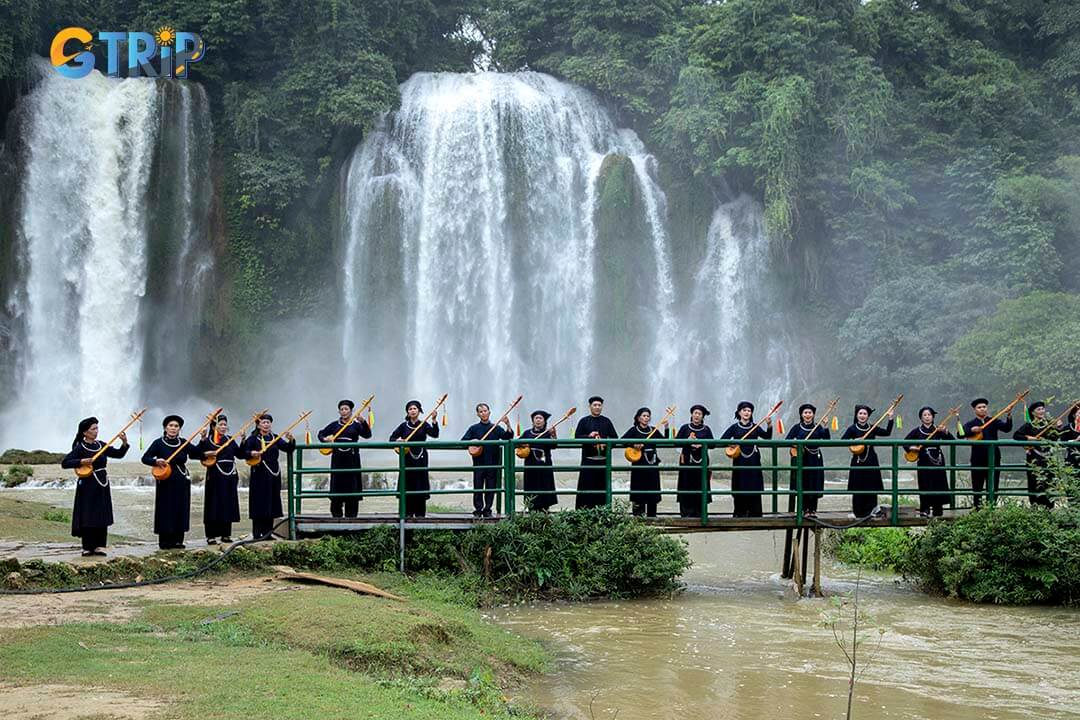
Engaging in local crafts, cuisine, and traditions at Ban Gioc offers an authentic glimpse into the rich cultural heritage of the Tay and Nung communities
4. Check-in at Milestone 836
A visit to Ban Gioc isn’t complete without checking in at Milestone 836, marking the Vietnam-China border. This milestone is unique as it is a double marker, with two stones bearing the same number. On the Vietnamese side stands Milestone 836 (2), while Milestone 836 (1) is positioned directly across the border in China.
Milestone 836 (2) stands on the Vietnamese side, near the entrance to Ban Gioc Waterfall. Made of granite, the milestone is engraved with the Vietnamese national emblem and the number 836. It serves as an important historical and geopolitical landmark, marking the official territorial division between the two nations. While tourists are free to take photos at the Vietnamese milestone, crossing over to the Chinese side is not permitted without proper border-crossing procedures.
Visiting Milestone 836 is not just about taking a memorable photo. It represents an opportunity to reflect on the history of Vietnam-China relations, particularly the border agreements that led to peaceful cooperation between the 2 countries. The 1999 Land Border Treaty played a crucial role in defining these border markers, ensuring clarity in territorial boundaries while promoting tourism and cross-border cultural exchanges.
For visitors, early morning or late afternoon is the best time for taking photos at Milestone 836, as the soft lighting enhances the natural beauty of the surroundings. The limestone karsts and lush greenery of Cao Bang create a picturesque backdrop, highlighting the region’s cultural and geographical significance. History buffs, geography lovers, and travelers seeking unique photos shouldn't miss Milestone 836 at Ban Gioc Waterfall.
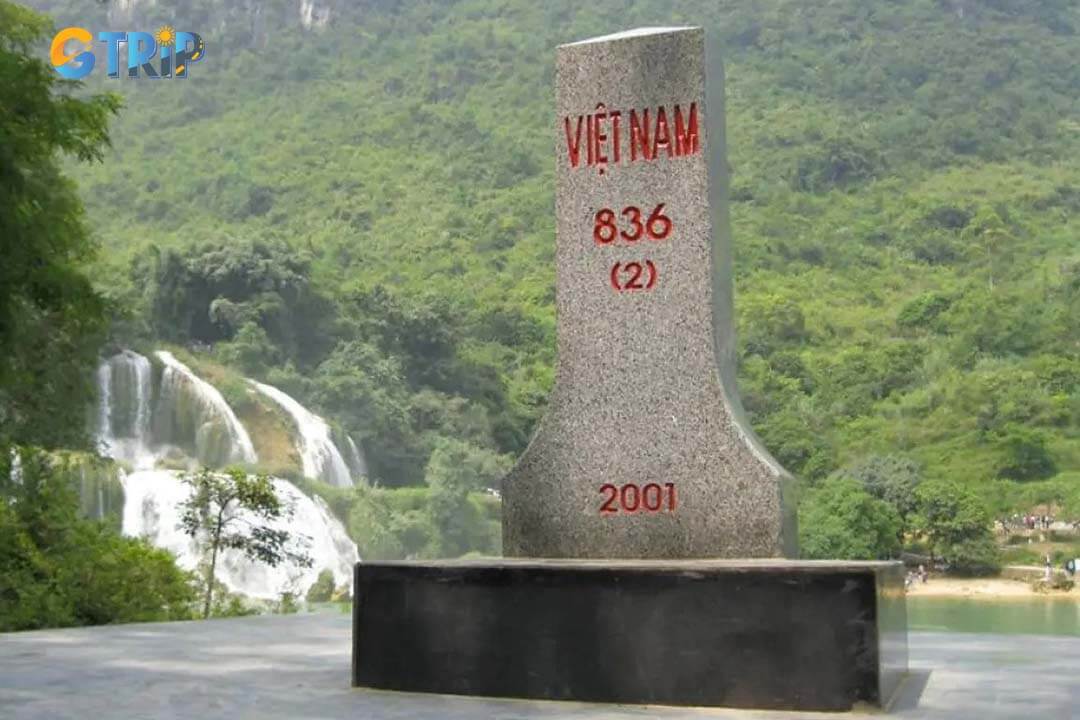
Milestone 836 at Ban Gioc Waterfall marks the Vietnam-China border, offering visitors a unique historical and geopolitical landmark to explore
When is the best time to visit Ban Gioc Waterfall?
Ban Gioc Waterfall offers a unique experience in every season, each with its charm depending on what you wish to experience. The best time to visit Ban Gioc Waterfall is September to December. During the peak season from September to October, the waterfall is at its most dramatic. This period marks the end of the rainy season when the Quay Son River reaches its highest water levels, producing a stunning cascade. Mild temperatures of around 20-25°C, coupled with lush greenery and clear skies, make it an ideal time for photography, sightseeing, and boat rides.
During the rainy season from May to August, the waterfall reaches its peak volume, and the surrounding karst mountains are cloaked in dense, vibrant green foliage. Despite the heat (25-30°C) and occasional heavy rain, this season attracts adventurers who embrace nature’s raw power and dramatic scenery.
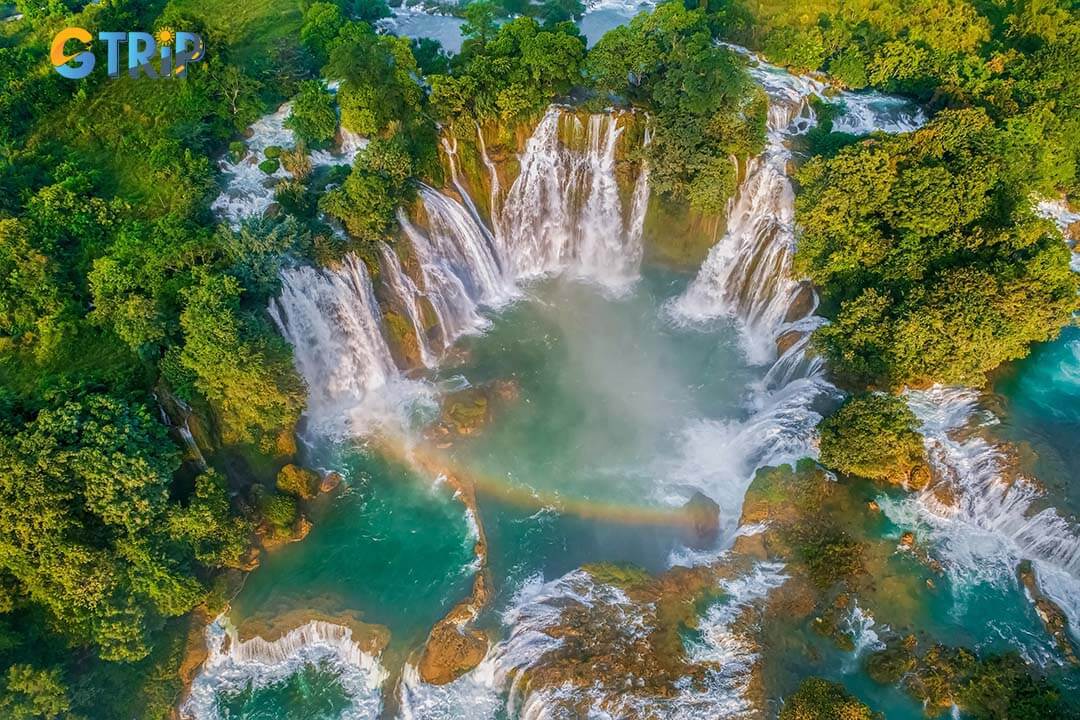
Ban Gioc Waterfall offers a unique charm in every season, from the dramatic cascades of the rainy season to the clear skies and lush landscapes of autumn
Opening hours and entrance fee of Ban Gioc Waterfall
Ban Gioc Waterfall welcomes visitors year-round, but its opening hours vary by season. During summer, the site operates from 7:00 AM to 6:00 PM, while in winter, it is open from 7:30 AM to 5:30 PM. Arriving early in the morning or late in the afternoon is recommended to enjoy the serene beauty of the falls without large crowds.
The entrance fee for Ban Gioc Waterfall is 45,000 VND per adult, while children between 1 meter and 1.3 meters tall pay a reduced fee of 20,000 VND. Children under 1 meter in height can enter for free.
Besides the entrance fee, visitors can enhance their experience by renting a raft for 50,000 VND per person, allowing them to get closer to the cascading waters.
Other optional services include:
- Mat rentals: 30,000 VND per mat
- Horse photography: 20,000 VND per person
- Motorbike parking: 10,000 VND per motorbike.
Tickets can be purchased at the entrance gate, and while prices are generally stable, it’s best to carry cash as digital payment options may not always be available. Since Ban Gioc Waterfall is located near the Vietnam-China border, you should also bring personal identification for security checks if required.
How to get to Ban Gioc Waterfall?
Ban Gioc Waterfall is located in Cao Bang province, approximately 333 km from Hanoi. Travelers can reach the site using various transportation modes, each offering different levels of comfort and flexibility.
| Mode of transport | Duration | Cost (Approx.) | Pros | Cons |
|---|---|---|---|---|
| Private car | 6-7 hours | Around $120-$150 (approx. 2,760,000 - 3,450,000 VND) | Comfort, flexibility, direct route | Higher cost |
| Bus + taxi | 7-8 hours | Around $10-$15 (bus) + $10-$20 (taxi) (approx. 230,000-345,000 VND for bus and 230,000-460,000 VND for taxi) | Budget-friendly | Longer travel time, transfers needed |
| Motorbike | 7-8 hours | Around $10-$20 (rental per day) (approx. 230,000 - 460,000 VND) | The scenic route, adventurous | Fatigue, weather-dependent |
| Guided tour | Full-day or 2-day trips | Around $50-$100 (per person) (approx. 1,150,000 - 2,300,000 VND) | Hassle-free includes meals & guide | Fixed itinerary |
Below are some detailed breakdowns of routes:
By private car or taxi:
- The best option for those seeking comfort and direct access.
- Route: Hanoi → Lang Son → Dong Dang → Cao Bang → Ban Gioc Waterfall.
- Can be booked via tour agencies or private drivers.
By bus:
- Budget-friendly but requires multiple transfers.
- Steps: Take a sleeper bus from My Dinh Bus Station (Hanoi) to Cao Bang City (6 hours). Then, take a local bus or taxi to Ban Gioc (1.5-2 hours).
- Recommended bus operators: Kumho, Thanh Ly, and Ha Thanh.
By motorbike:
- Suitable for experienced riders who enjoy road trips through northern Vietnam’s mountainous landscapes.
- Route: Hanoi → Thai Nguyen → Bac Kan → Cao Bang → Ban Gioc.
- Note: Requires a valid motorbike license and travel insurance.

Ban Gioc Waterfall is about 333 km from Hanoi and accessible by various transportation options
Where to stay near Ban Gioc Waterfall?
Although Ban Gioc Waterfall is in a remote area, you can find various accommodation options nearby, ranging from budget-friendly homestays to comfortable hotels.
Sai Gon Ban Gioc Resort
- Address: Provincial Road 206, Ban Ban hamlet, Dam Thuy Commune, Trung Khanh District, Cao Bang Province
- Phone: 0915 424 228
- Prices range: 1,170,000 VND - 1,350,000 VND ($45.82-$52.87)
- Highlight: Enjoy panoramic views of Ban Gioc Waterfall with modern amenities like air conditioning, free Wi-Fi, and spacious, well-appointed rooms that blend luxury with the natural beauty of Cao Bang.
Khuoi Ky Eco Homestay
- Address: The road to Ngao Khuoi Ky - Dam Thuy -Tram Khanh - Cao Bang, Cao Bang
- Phone: 0912 510 563
- Prices range: 130,000 VND - 700,000 VND ($5.09-$27.41)
- Highlight: Experience authentic rural charm in an eco-friendly setting, where traditional decor, a serene atmosphere, and genuine local hospitality offer a peaceful retreat along the road to Ngao Khuoi Ky.
Yen Nhi Homestay (Traditional house)
- Address: Khuoi Ky Stone Village, Ban Gioc, Trung Khanh District, Cao Bang
- Phone: 0942 241 760
- Prices range: 650,000 VND - 800,000 VND ($25.46 - $31.33)
- Highlight: Immerse yourself in cultural heritage at Yen Nhi Homestay, a beautifully restored traditional stone house that combines rustic charm with modern comforts and warm, personalized service.
Planning a trip to Ban Gioc Waterfall requires considering the best travel season, transportation options, and accommodation choices. If you’re looking for a thrilling adventure, a cultural immersion, or a relaxing escape, Ban Gioc has something to offer year-round. By following this guide, you can maximize your experience and explore the stunning landscapes of Cao Bang Province with ease.
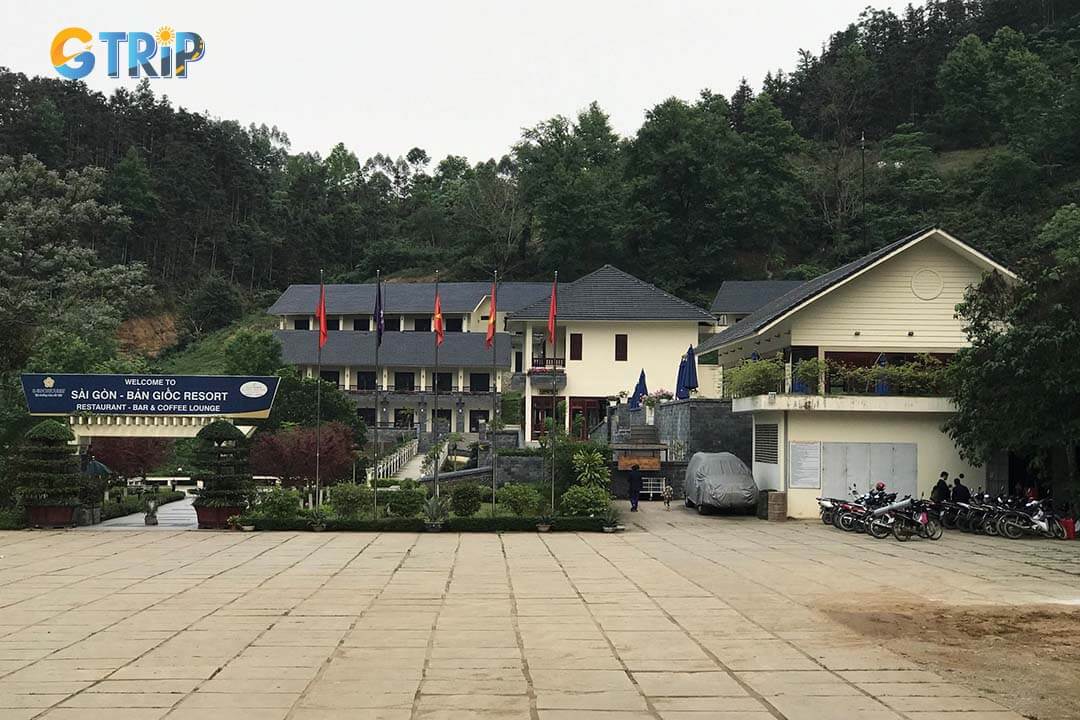
Despite its remote location, Ban Gioc Waterfall offers a range of accommodations, from budget homestays to scenic resorts, ensuring a comfortable stay for all travelers
Nearby attractions from Ban Gioc Waterfall
Ban Gioc Waterfall is an isolated wonder, it is surrounded by a landscape rich in natural beauty and geological marvels. The region's karst formations, limestone caves, and tranquil lakes create a captivating environment for exploration. Among the must-visit attractions nearby, Nguom Ngao Cave and Truc Lam Ban Gioc Pagoda stand out, offering a balance between nature's raw power and cultural serenity.
Nguom Ngao Cave (3.8 km)
Located approximately 3.8 kilometers from Ban Gioc Waterfall, Nguom Ngao Cave is recognized as one of Vietnam’s most extraordinary limestone caves. Shaped over millions of years, the cave’s stalactites, stalagmites, and passages reveal water’s relentless erosion of ancient limestone. Tourists embark on a surreal journey through a cavern system that stretches for over 2,100 meters (approx. 2144 meters), although only approximately one kilometer of it is accessible for exploration.
The stalactites inspire tourists' imaginations by resembling people, trees, animals, fairies, or lotus blossoms that look like a limestone column intricately resembling a blooming lotus flower. The cave maintains a cool temperature of 18-25°C year-round, providing a refreshing contrast to the humid climate outside. Illuminated by strategically placed lighting, the otherworldly formations create an ethereal atmosphere, making it a haven for photography and geological enthusiasts.
Nguom Ngao Cave holds deep significance for the Tay and Nung ethnic groups, who believe it was once a refuge during times of conflict. According to legend, the name “Nguom Ngao” translates to "Tiger Cave", as locals believed that mystical tigers once lived within its depths. Today, it is a symbol of Cao Bang’s geological and cultural heritage.
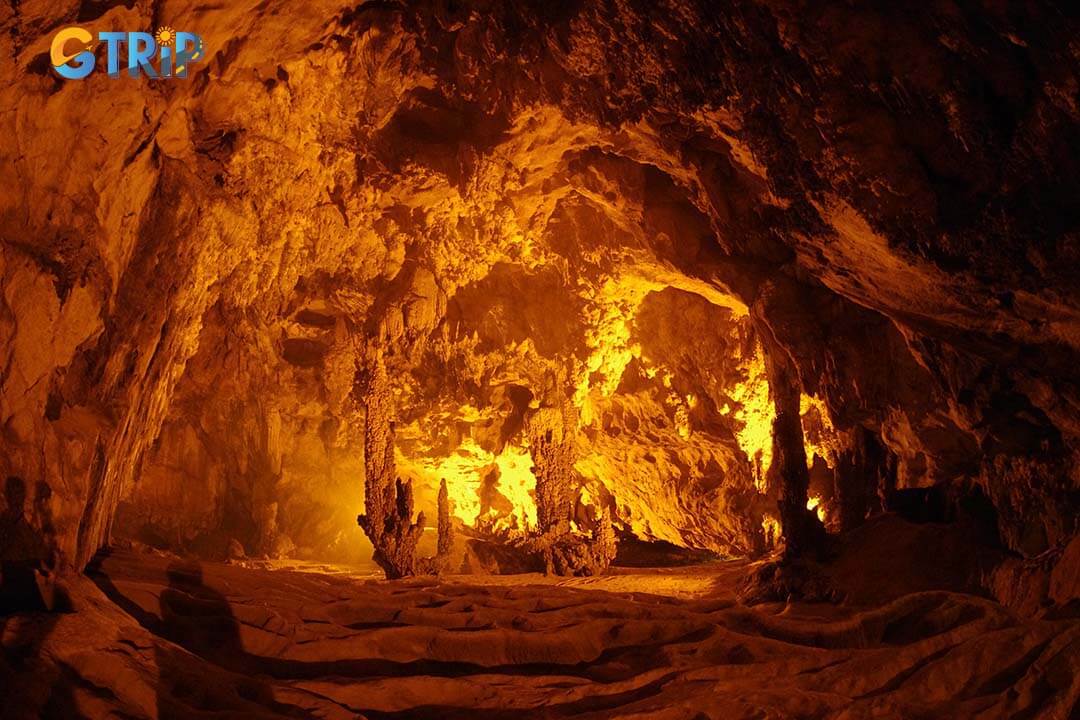
Nguom Ngao Cave is a breathtaking limestone wonder, featuring stunning rock formations and a cool, mystical atmosphere
Phat Tich Truc Lam Ban Gioc Pagoda (700 m)
Truc Lam Ban Gioc Pagoda is perched on Phia Nham Mountain, just 700 meters from Ban Gioc Waterfall and located in Dam Thuy Commune, Trung Khanh District, Cao Bang Province. Truc Lam Ban Gioc Pagoda is a rare example of a Vietnamese Buddhist temple constructed near an international border. The temple follows the traditional Truc Lam Zen School, emphasizing meditation and mindfulness.
Built-in 2014, the pagoda blends harmoniously with its natural surroundings. The complex features:
- A grand entrance gate (Tam Quan) - A traditional wooden structure symbolizing spiritual entry.
- The main sanctuary (Chinh Dien) - Housing statues of Buddha and revered monks.
- The bell tower (Gac Chuong) - Offers panoramic views of Ban Gioc Waterfall and the Quay Son River.
Perched on high ground, the pagoda offers visitors a stunning panoramic view of Ban Gioc Waterfall tumbling down limestone cliffs, surrounded by lush greenery. The peaceful atmosphere makes it an ideal spot for meditation and reflection. Truc Lam Ban Gioc Pagoda serves as both a spiritual retreat and a cultural landmark, fostering cross-border peace and harmony between Vietnam and China. Pilgrims visit the pagoda to pray for blessings, while tourists find solace in its tranquil ambiance.
Khuoi Ky Ancient Stone Village (2.6 km)
Khuoi Ky Ancient Stone Village is located on the road to Nguom Ngao, Dam Thuy, Trung Khanh, Cao Bang. It is a living testament to the rich cultural heritage of Cao Bang Province. This historic village is renowned for its traditional stone houses, built by the local Tay and Nung communities over generations. The village’s architecture characterized by sturdy, weathered stone structures reflects a deep connection to the land and offers a unique glimpse into the region’s ancestral lifestyle.
Walking through the narrow alleys of Khuoi Ky, you can admire ancient relics and traditional craftsmanship that have been preserved over time. The village remains vibrant, with locals continuing time-honored practices such as stone carving, weaving, and other artisanal trades that have defined their cultural identity. Guided tours are available, providing insights into local legends, historical rituals, and the intricate techniques used in stone construction.
Khuoi Ky’s serene ambiance is enriched by lush greenery and the distant murmur of Ban Gioc Waterfall, creating a tranquil setting for reflection and exploration. A visit to Khuoi Ky Ancient Stone Village offers a captivating glimpse into history, architecture, and authentic rural life amid northern Vietnam’s natural beauty.
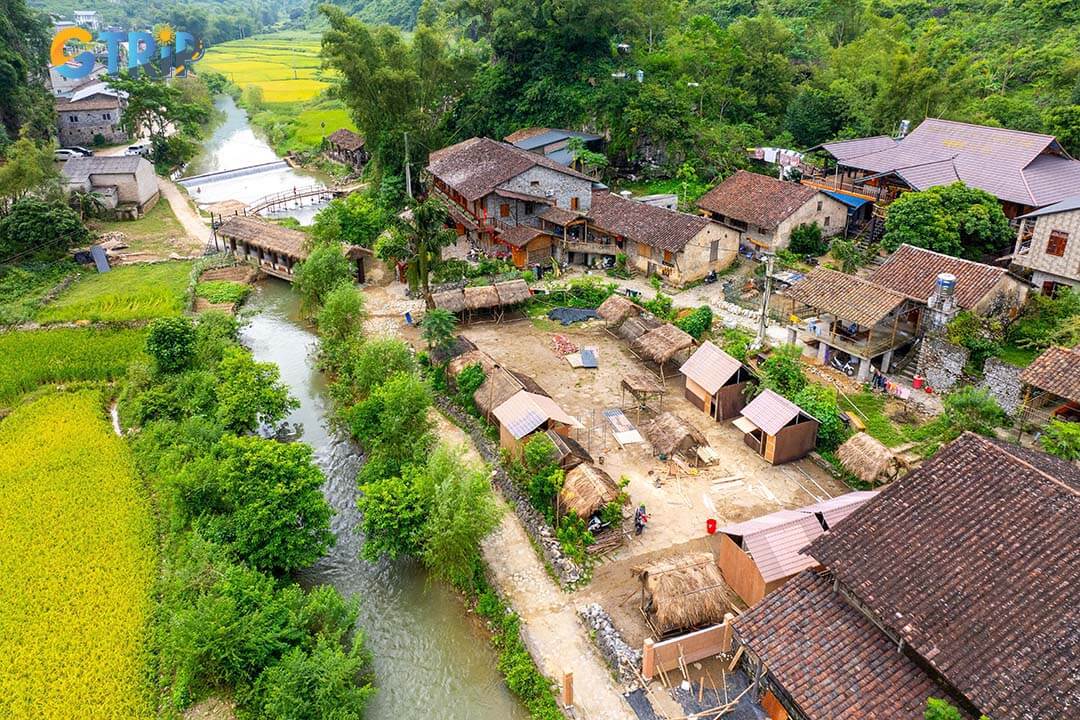
Khuoi Ky Ancient Stone Village showcases traditional stone houses of the Tay and Nung people, offering a glimpse into Cao Bang’s rich cultural heritage
What to eat when visiting Ban Gioc Waterfalls?
Cao Bang’s cuisine is a reflection of its rich cultural heritage, blending fresh local ingredients with unique preparation techniques. Each dish, from delicate steamed rice rolls to colorful sticky rice, embodies the region’s rich traditions and distinctive flavors. Here are some must-try specialties that showcase the region’s culinary charm.
- Banh cuon Cao Bang (Cao Bang steamed rice rolls): Enjoy these delicate steamed rice rolls filled with a savory mixture of minced meat and mushrooms, served with fresh herbs and a tangy dipping sauce, a local breakfast favorite that reflects the region’s culinary tradition.
- Vit quay 7 mon (Seven-dish roasted duck): Savor the rich flavors of this local specialty, where perfectly roasted duck is prepared in seven distinct styles, each offering a unique blend of spices and techniques that highlight the diverse influences of northern Vietnamese cuisine.
- Pho chua Cao Bang (Sour noodle soup): Try this refreshing twist on traditional pho, featuring a light, sour broth enriched with local herbs, vegetables, and tender slices of meat. Its tangy flavor profile provides a delightful contrast to the region's typical savory dishes.
- Xoi ngu sac (Five-color sticky rice): Indulge in this visually striking and flavorful dish, where sticky rice is mixed with naturally colored ingredients to create a vibrant mosaic of flavors and textures, a festive treat often enjoyed during local celebrations.
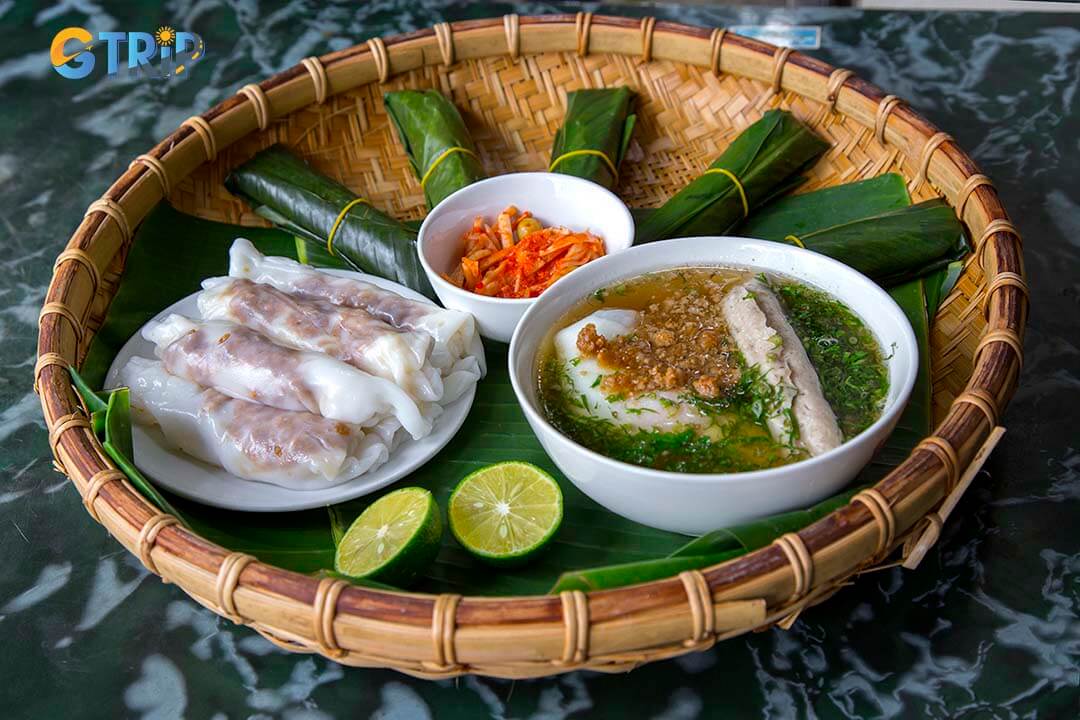
Cao Bang’s cuisine blends fresh local ingredients with traditional techniques, offering specialties like steamed rice rolls, sour noodle soup, and five-color sticky rice
Practical tips for travelers when visiting Ban Gioc Waterfall
Exploring Ban Gioc Waterfall offers an unforgettable outdoor adventure, but ensuring a safe and responsible visit is essential. By prioritizing health, safety, and environmental responsibility, you can fully enjoy your journey while preserving the natural beauty and cultural heritage of Ban Gioc.
Safety and health precautions
Visiting Ban Gioc Waterfall involves outdoor activities such as trekking, boat rides, and exploring nearby caves. While the area is generally safe, tourists should consider the following precautions:
Health considerations
- Vaccinations: Recommended vaccines include hepatitis A, typhoid, and tetanus.
- Food & water safety: Avoid drinking tap water, you should choose bottled or filtered water. Street food is generally safe but choose vendors with good hygiene practices.
- Altitude & terrain: The waterfall is located at an elevation of approximately 500 meters, with some uneven terrain requiring proper footwear.
Weather & natural hazards
- The rainy season (May-August): Heavy rains can cause slippery conditions and rising water levels, making certain trails dangerous.
- Dry season (November - April): Ideal for travel, but expect cooler temperatures in the mornings and evenings.
- Strong currents: Swimming is not allowed due to strong undercurrents, but boat rides are available for close-up views.
Wildlife awareness
- Insects & mosquitoes: Carry insect repellent, especially in forested areas.
- Snakes & wildlife: Rare but possible encounters; avoid off-trail hiking.
- Livestock on roads: If traveling by motorbike, be cautious of free-roaming animals.
Environmental responsibility
Ban Gioc Waterfall is a pristine natural site that requires responsible tourism practices to preserve its beauty. Visitors should follow sustainable travel guidelines:
Minimizing environmental impact
- No plastic waste: Bring a reusable water bottle and avoid single-use plastics.
- Respect local flora & fauna: You shouldn’t pick plants, disturb animals, or leave food scraps behind.
- Eco-friendly accommodations: Choose lodgings that follow sustainable practices, such as homestays using solar energy or local materials.
Cultural & local community respect
- Respecting ethnic traditions: The region is home to the Tay and Nung ethnic groups, who have distinct cultural practices. Always ask for permission before taking photos of locals.
- Supporting the local economy: Buy handicrafts from village markets rather than mass-produced souvenirs.
- Responsible trekking: Stick to marked trails to avoid soil erosion and protect fragile ecosystems.

When visiting Ban Gioc, follow health precautions, check weather conditions, respect wildlife, and practice responsible tourism
Ban Gioc Waterfall is more than just a breathtaking natural wonder - it's a destination that blends dramatic landscapes, cultural richness, and historical significance. With its majestic cascades, hidden caves, serene lakes, and ancient temples, this region promises a captivating journey for nature enthusiasts, history lovers, and thrill-seekers.
This guide has covered everything from the best time to visit, nearby attractions, and cultural insights to practical travel tips. If you’re planning a solo journey, a guided tour, or an off-the-beaten-path adventure, Ban Gioc promises an unforgettable experience. For a seamless trip, consider exploring Vietnam tour packages that include Ban Gioc and other must-visit destinations. You can also rely on GTrip - Vietnam Travel Agency for expertly curated itineraries and local insights.

